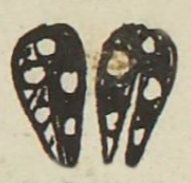zolin (MH514r)
This element consists of a frontal view of two upright quail (zolin) feathers. It comes from the compound personal name, Cuazol. The distinctive black and white pattern on the feathers is diagnostic for the bird. Here, the feathers are black with large white spots.
Stephanie Wood
The quail had a role in the religious life of the Nahuas, largely serving as offerings. Their remains are very prevalent in the finds at the Templo Mayor, and they are prominent in the Mixtecs' Codex Nuttall. For further information see Elena Mazzetto, "Quail in the Religious Life of the Ancient Nahuas", en Milbrath, Susan y Elizabeth Baquedano (coords.), 2023, Birds and Beasts of Ancient Mesoamerica. Animal Symbolism in the Postclassic Period, Denver, University Press of Colorado, pp. 200-219.
Stephanie Wood
1560
Jeff Haskett-Wood
pájaros, codornices, birds, feathers, plumas, manchado, moteado

zol(in), quail, https://nahuatl.wired-humanities.org/content/zolin
el codorniz
Matrícula de Huexotzinco, folio 514r, World Digital Library, https://www.loc.gov/resource/gdcwdl.wdl_15282/?sp=107&st=image
This manuscript is hosted by the Library of Congress and the World Digital Library; used here with the Creative Commons, “Attribution-NonCommercial-ShareAlike 3.0 License” (CC-BY-NC-SAq 3.0).





